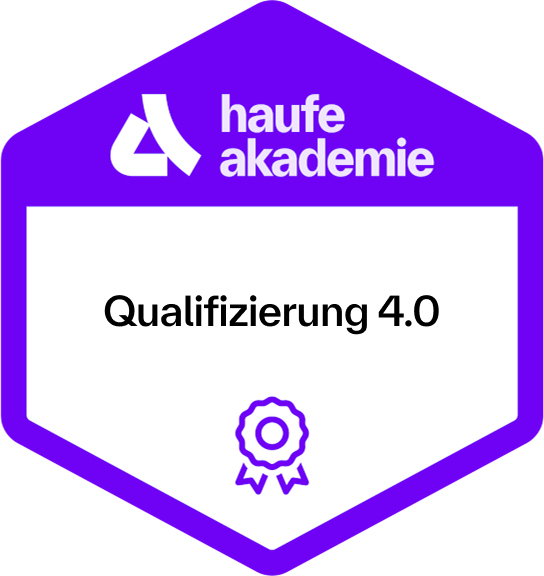Practical implementation of data analytics and data science with KNIME
Data projects with artificial intelligence - without programming

The first webinar starts with a detailed presentation of the structure and objectives of the course. Together, we will also take a look at the first learning units and discuss personal expectations.
Part 1: Business understanding and concepts of data mining
At the beginning of the first self-study unit, you will learn to identify use cases and describe how you can solve business problems by analyzing data and applying machine learning. You will then learn all about the basics and requirements for your own data projects and dive deep into the concepts of data structures and machine learning:
- Knowledge check on data science and artificial intelligence
- The skills and role of the data scientist
- The composition of data teams
- Vertical fields of application in companies
- Horizontal fields of application in companies
- Supervised learning: classification, regression, time series
- Unsupervised learning: segments, anomalies, patterns
- Reinforcement learning
- Collect data and assess relevance
- Big data, data types, data structures
- Data integration, data sources, databases
- Data warehouse, virtual databases and data lake
Part 2: Installation and introduction to working with KNIME
After you have learned all about the basics and concepts of data science, the next step is to take your first steps in practical application. You will familiarize yourself with the use of the KNIME tool, a powerful development platform for data mining, with which you can carry out complex data analysis and data science projects:
- Set up installation and workspace
- The concept of nodes and workflows
- Getting to know the user interface
- Excel Reader and configuration menu
- Outputs and other import nodes
- Documentation and workflow organization
In the second webinar, you will review the content of the first self-study phase together with the trainers .
In this module, you will learn all the steps and concepts for preparing the data for the modeling process. First, you will analyse the data by applying different visualization techniques to identify patterns, trends and outliers. You will then clean the data and prepare it for transformation:
- Data preparation: Recognizing problems
- Strategies for solving problems
- Harmonization of time series
- Data visualization and data analysis
- Tables, diagrams, parameters, covariance
- Data visualization in KNIME
- Data cleansing in KNIME
- Data transformation in KNIME
- Exercise project for data preparation
In the third webinar, you will focus on the exercise project together with the speaker. A possible solution will be presented. Of course, there will also be ample opportunity to ask questions.
Now it's time for modeling based on the data. You will first learn how to find the right algorithm and methodology to achieve optimal results. You will then focus on how to adequately evaluate and interpret the results of the models. In practical exercises, you will carry out the processes yourself in KNIME and also implement more complex classification and clustering tasks:
- Properties for modeling
- Select algorithm and methodology: Classification and KNN
- Evaluate result: Classification and KNN
- Machine Learning in KNIME: Classification
- Select algorithm and methodology: Regression and clustering
- Evaluate the result: Regression and clustering
- Machine learning in KNIME: complex classification and clustering
- Exercise project for creating the data model
You will use the fourth webinar for another deep dive into modeling concepts. You will review the most important facts about algorithms and methodologies and focus in particular on evaluating the results of the models used.
The fourth self-learning phase deals with the final steps in the CRISP-DM process, the evaluation and deployment of the data model. Here, too, you will proceed step by step using instructions and your own practical tasks in KNIME. At the end, you will put the entire process into production and transfer it to an automated KNIME workflow:
- Implementation of the model
- Structured testing of the model
- Systematic troubleshooting
- Monitoring and verification
- Maintenance and updating
- Exporting data to databases
- Creating and sending reports
- Automated execution of the KNIME workflow
- Practice project on evaluation and deployment
In the final webinar, you will focus on the exercise project from Module 8. In addition to insights for solutions to the task, you will also receive tips and advice from the instructor on how to prepare for the final exam.
Contents
1. business understanding for data analysis
- Knowledge check on data science and artificial intelligence
- The skills and role of the data scientist
- The composition of data teams
- Vertical fields of application in companies
- Horizontal fields of application in companies
- Supervised learning: classification, regression, time series
- Unsupervised learning: segments, anomalies, patterns
- Reinforcement learning
- Collect data and assess relevance
- Big data, data types, data structures
- Data integration, data sources, databases
- Data warehouse, virtual databases and data lake
2. operation and first steps in KNIME
- Set up installation and workspace
- The concept of nodes and workflows
- Getting to know the user interface
- Excel Reader and configuration menu
- Outputs and other import nodes
- Documentation and workflow organization
3. data understanding and data preparation
- Data preparation: Recognizing problems
- Strategies for solving problems
- Harmonization of time series
- Data visualization and data analysis
- Tables, diagrams, parameters, covariance
- Data visualization in KNIME
- Data cleansing in KNIME
- Data transformation in KNIME
4. data modeling
- Properties for modeling
- Select algorithm and methodology: Classification and KNN
- Evaluate result: Classification and KNN
- Machine Learning in KNIME: Classification
- Select algorithm and methodology: Regression and clustering
- Evaluate the result: Regression and clustering
- Machine learning in KNIME: complex classification and clustering
5. deployment, monitoring and troubleshooting
- Implementation of the model
- Structured testing of the model
- Systematic troubleshooting
- Monitoring and verification
- Maintenance and updating
- Exporting data to databases
- Creating and sending reports
- Automated execution of the KNIME workflow
6. final project
After the practical tasks, with which various scenarios and the individual stages of the CRISP-DM process are practiced, there is a final project at the end of the course in which the entire data analysis process is run through.
This is how you learn in this course
This course offers you a digital blended concept that has been developed for part-time learning. Thanks to a flexible mix of online seminars and self-study phases, you are sure to reach your goal. This is how you learn in this course:
Learning environment: In your online learning environment, you will find useful information, downloads and extra services for this training course after you have registered.
Self-study phases: Learn independently, at your own pace and whenever you want. Our courses offer you didactically high-quality learning material.
Live webinars: In regular online seminars, you will meet your trainers in person. You will receive answers to your questions, specific assistance and instructions on how to deepen your knowledge and apply the skills you have acquired in practical exercises.
Learning community: A digital learning community is available to you throughout the course. Exchange ideas with other participants and the trainers and ask questions.
Future Jobs Club: Get exclusive access to a business network, news and future work hacks.
Certificate of attendance and Open Badge: As a graduate of the course, you will receive a certificate of attendance and an Open Badge, which you can easily share in professional networks (e.g. LinkedIn).
Your benefit
After this course, you will be able to independently master all important tasks in data analysis and data science:
- Comprehensive knowledge: You will gain an in-depth understanding of all relevant topics relating to data science, artificial intelligence and machine learning.
- Project management: You are able to organize, design and implement data and AI projects in your company.
- Business Understanding: You will develop versatile approaches to effectively understand and utilize business data and analytics.
- Data handling: You can import and structure large amounts of data and qualify it for analysis.
- Analyses and visualizations: You create meaningful data analyses and visualize them convincingly.
- Predictive analyses: You make reliable predictions using predictive data analyses.
- Model training: You train data models with supervised, unsupervised and reinforcement learning.
- Model production: You bring your trained models into production and integrate them into automation processes.
- KNIME expertise: You use the open source software KNIME for professional data projects.
Methods
Teaching content via digital components such as e-learning, interactive exercises, webinars, learning assessments and more. Exchange with learners and experts via a community. Location-independent and accessible at any time. Mobile learning when and where you want!
Tool
Recommended for
This course is aimed at professionals from all industries who would like to train as a data analyst or data scientist. It is equally suitable for newcomers and career changers as well as for people with previous knowledge who want to sharpen their tasks and role and make a greater impact with their work.
Programming skills are not required! Basic knowledge of data science is required.
We recommend that you attend the Smart Data Science course (bookable as an online course (31549) or classroom seminar (30298)) before attending this course.
Further recommendations for "Practical implementation of data analytics and data science with KNIME"
Start dates and details


 3.8
3.8





